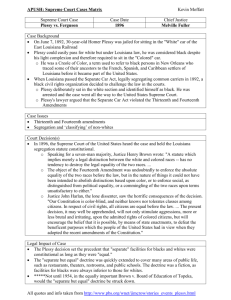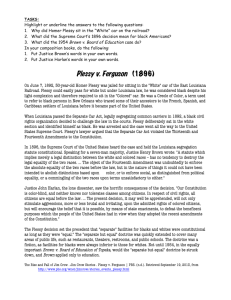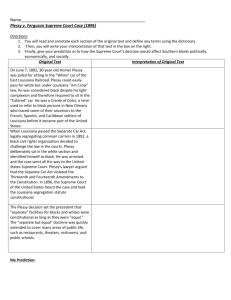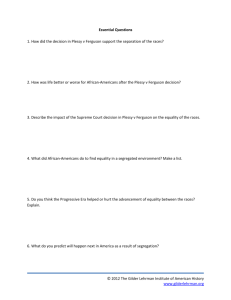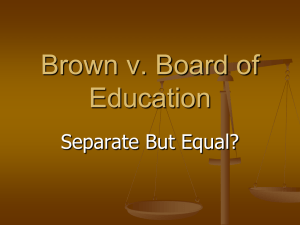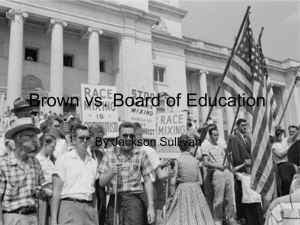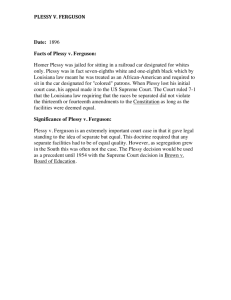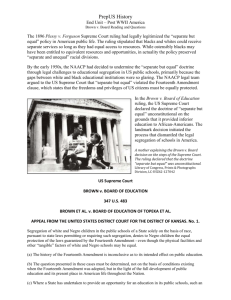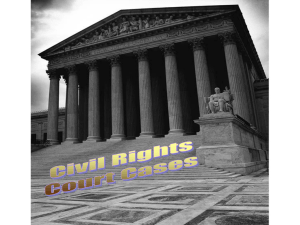Plessy v Fergusson reading
advertisement
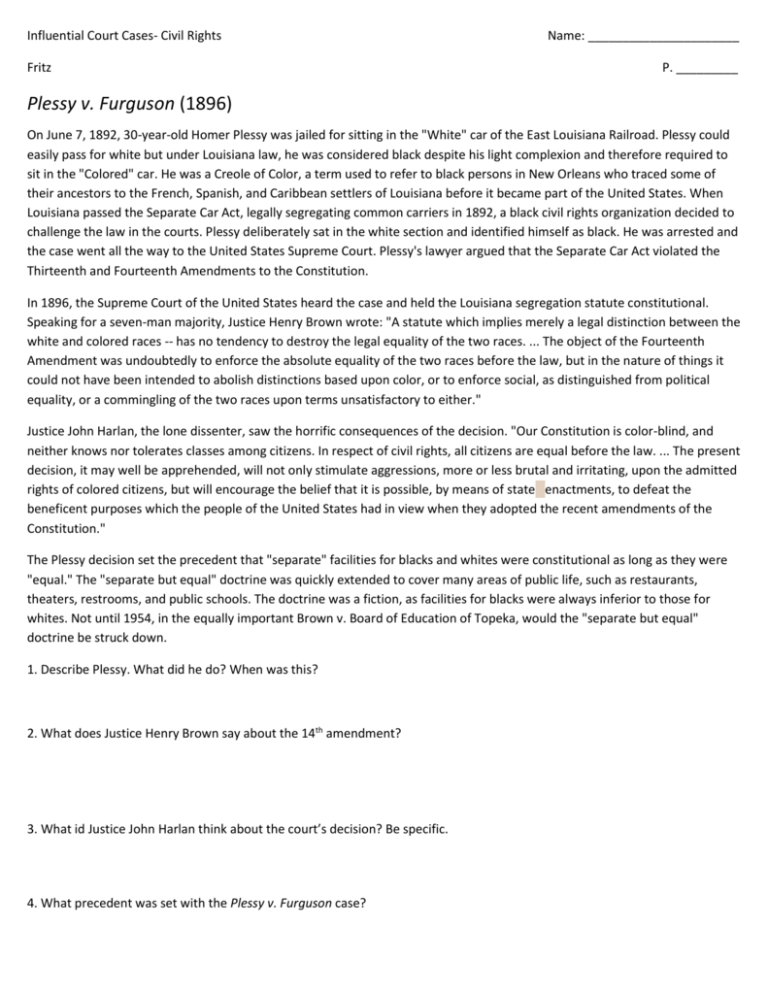
Influential Court Cases- Civil Rights Fritz Name: ______________________ P. _________ Plessy v. Furguson (1896) On June 7, 1892, 30-year-old Homer Plessy was jailed for sitting in the "White" car of the East Louisiana Railroad. Plessy could easily pass for white but under Louisiana law, he was considered black despite his light complexion and therefore required to sit in the "Colored" car. He was a Creole of Color, a term used to refer to black persons in New Orleans who traced some of their ancestors to the French, Spanish, and Caribbean settlers of Louisiana before it became part of the United States. When Louisiana passed the Separate Car Act, legally segregating common carriers in 1892, a black civil rights organization decided to challenge the law in the courts. Plessy deliberately sat in the white section and identified himself as black. He was arrested and the case went all the way to the United States Supreme Court. Plessy's lawyer argued that the Separate Car Act violated the Thirteenth and Fourteenth Amendments to the Constitution. In 1896, the Supreme Court of the United States heard the case and held the Louisiana segregation statute constitutional. Speaking for a seven-man majority, Justice Henry Brown wrote: "A statute which implies merely a legal distinction between the white and colored races -- has no tendency to destroy the legal equality of the two races. ... The object of the Fourteenth Amendment was undoubtedly to enforce the absolute equality of the two races before the law, but in the nature of things it could not have been intended to abolish distinctions based upon color, or to enforce social, as distinguished from political equality, or a commingling of the two races upon terms unsatisfactory to either." Justice John Harlan, the lone dissenter, saw the horrific consequences of the decision. "Our Constitution is color-blind, and neither knows nor tolerates classes among citizens. In respect of civil rights, all citizens are equal before the law. ... The present decision, it may well be apprehended, will not only stimulate aggressions, more or less brutal and irritating, upon the admitted rights of colored citizens, but will encourage the belief that it is possible, by means of state enactments, to defeat the beneficent purposes which the people of the United States had in view when they adopted the recent amendments of the Constitution." The Plessy decision set the precedent that "separate" facilities for blacks and whites were constitutional as long as they were "equal." The "separate but equal" doctrine was quickly extended to cover many areas of public life, such as restaurants, theaters, restrooms, and public schools. The doctrine was a fiction, as facilities for blacks were always inferior to those for whites. Not until 1954, in the equally important Brown v. Board of Education of Topeka, would the "separate but equal" doctrine be struck down. 1. Describe Plessy. What did he do? When was this? 2. What does Justice Henry Brown say about the 14th amendment? 3. What id Justice John Harlan think about the court’s decision? Be specific. 4. What precedent was set with the Plessy v. Furguson case? Brown v. Board of Education (1954) Brown v. Board received its name from the lawsuit brought by the parents of eight-year-old Linda Brown, who had to travel a great distance to attend grade school while white children went to a school a few blocks away. The NAACP brought suit on behalf of her parents to admit her to her neighborhood school. The Brown case was one of a total of five cases charging that segregation in education was a violation of the equal protection of the laws clause of the Fourteenth Amendment. They included Briggs v. Elliot at al. (South Carolina) Davis at al. V. County School Board of Prince Edward County (Virginia); Gebhart et al. V. Benton (Delaware), and Bolling v. Sharpe (District of Columbia). Four of the cases were brought by the National Association For the Advancement of Colored People (NAACP) and were argued before the Supreme Court by Thurgood Marshall. Marshall would later become the first black justice on the Supreme Court. On May 17, 1954, the U.S. Supreme Court ruled unanimously that racial segregation in public schools violated the Fourteenth Amendment to the Constitution, which says that no state may deny equal protection of the laws to any person within its jurisdiction. The 1954 decision declared that separate educational facilities were inherently unequal. Following a series of Supreme Court cases argued between 1938 and 1950 that chipped away at legalized segregation, Brown v. Board of Education of Topeka reversed an earlier Supreme Court ruling (Plessy v. Ferguson, 1896) that permitted "separate but equal" public facilities. The 1954 decision was limited to the public schools, but it was believed to imply that segregation was not permissible in other public facilities. The key phrase in the ruling delivered by Chief Justice Earl Warren was as follows: "Segregation of white and colored children in public schools has a detrimental effect upon the colored children. The impact is greater when it has the sanction of the law, for the policy of separating the races is usually interpreted as denoting the inferiority of the Negro group. A sense of inferiority affects the motivation of a child to learn. Segregation with the sanction of law, therefore, has a tendency to [retard] the educational and mental development of Negro children and to deprive them of some of the benefits they would receive in a racially integrated school system. ... We conclude that, in the field of public education, the doctrine of "separate but equal" has no place. Separate educational facilities are inherently unequal." 1. Where did Brown v. Board get its name? Describe the problem that occurred: 2. What did the Supreme Court decide in May, 1954? What was the significance? 3. What did the Plessy v. Furguson court case argue? 4. What was Chief Justice Earl Warren’s ruling? Refer to the quote and summarize it: 5. Plessy v. Furguson is like _____________________________ (least favorite food) because: 6. Brown v. Board of Education is like _________________________ (favorite season) because:
